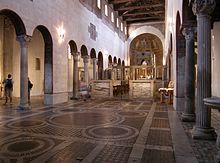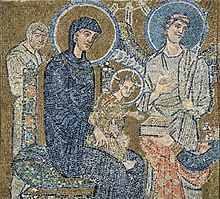Santa Maria in Cosmedin

The Basilica minor Santa Maria in Cosmedin ( Latin Sanctae Mariae in Cosmedin ), originally Santa Maria in Schola Graeca , is a church in Rome near the banks of the Tiber in Piazza Bocca della Verità . It was consecrated at the end of the 6th century and has the patronage of St. Mary . The titeldiakonie belongs to the Melkite Greek Catholic Church and is the rectorate church of the parish of Santa Prisca . The Bocca della Verità (“Mouth of Truth”) is located in the vestibule .
Previous buildings
No later than the 6th century BC. At a crossing over the Tiber, the Forum Boarium was the first and most important trading center in Rome. A number of religious and public buildings have been erected in this market over the centuries, of which the Temple of Portunus (formerly known as the Temple of Fortuna Virilis ) and the Temple of Hercules Victor (formerly known as the Temple of Vesta ) are preserved.
In the area of today's church there were three other temples dedicated to Hercules : The Ara Maxima , which is said to go back to the founding time of Rome, the temple of Hercules Invictus and the temple of Hercules Pompeianus . Since the 1st century AD, the Statio Annonae , which served to dispense grain to the population, was located next to these temples . In the east, the church encroaches on the area that was built on by the Circus Maximus . Some ancient sewers run under the whole area, including the Cloaca Maxima .
Building history
In the columned hall ( loggia annonaria ) belonging to the Statio Annonae from the 1st century AD, a small church was built in transverse direction around 580 in such a way that the spaces between the columns were walled up and an apse facing east was added . The narrow, single-nave room stretched across the entire width of the portico. Columns of the ancient loggia can still be seen today on the north narrow side in the left aisle wall and in the entrance wall of the basilica. Since the Forum Boarium had been a settlement area for Greek merchants since the early days of Rome and therefore the quarter was named Schola Graeca in late antiquity , the church of Santa Maria in Schola Graeca was called.
For the first expansion of the church under Pope Hadrian I around 772, the growth of the Greek community in the time of the civil war-like iconoclasm in Byzantium was decisive, as a result of which many Greek refugees came to Rome. He had the temple of Hercules Pompeian torn down for the extension so that its foundations could be used for the church, which was extended from 17 m to 35 m. A three-aisled basilica was created in the original width of the ancient columned hall with an apse in the east, flanked by two side apses, as well as with a narthex and vestibule. A three-aisled crypt with spoli columns and a semicircular apse was built under the presbytery . Both the early Christian church and the 8th century basilica had a Marian patronage . In the Liber Pontificalis , the name addition Cosmedin is mentioned for the first time around 780 ; it is derived from the Greek word kosmein for "decorate" and was probably influenced by the Greek-born community as an expression of admiration for by Pope Hadrian donated precious interior . Under Pope Nicholas I (858–867) a house for the deacon was added to the sacristy and oratory .
In 1118 Pope Gelasius II had the basilica renovated, which had been devastated during an invasion by the Normans . A pillar change was installed in the central nave , where three ancient spoli columns with wide support pillars alternate. In the 12th century the campanile and the narthex were also created in their current form.
In 1718 Giuseppe Sardi gave the church a baroque style and an elegant rococo facade . In 1899 the architect Giovanni Battista Giovenale ordered the removal of the Gothic and Baroque fixtures, so that the interior now gives the impression that no significant changes had been made since 1123; During this measure the apse frescoes in the style of the 12th century were created.
The surroundings of the church were severely affected by the construction of new roads during the reign of Benito Mussolini .
inner space
Inside, the structure of the Statio Annonae is still clearly recognizable from the preserved 18 Corinthian columns . Around 1120 the church received a Kosmaten floor and a Schola cantorum with exceptionally valuable marble furnishings; the room for the schola was separated from the chancel and the nave by marble barriers with beams. The two ambones for the epistle and the gospel as well as the bishop's seat in the main apse with two presumably antique lion heads should be emphasized . The Easter candlestick signed Fra Pasquale was added around 1280 . Above the altar of the 8th century in 1295 which placed the artist Deonato signed ciborium erected.
The two cycles of 24 murals each from the first third of the 12th century are among the most important of this period in Rome. The following are shown: on the right, scenes from the Book of Daniel and below that Jesus' miraculous healings and his entry into Jerusalem ; left scenes from the vita of Charlemagne and below pictures from the life of Mary.
In the former sacristy a fragment of a mosaic is kept, which represents the left half of the picture of an Adoration of the Three Wise Men ; it was commissioned by Pope John VII (705–707) for his burial chapel (oratorio John VII) in the outer right aisle of Alt-St. Peter was created by Byzantine artists. Mary sits with her child on a throne-like chair, surrounded by two angels as throne guard, behind her Joseph. The star shines with three bundles of rays above the baby Jesus. The first of the three magicians is about to kneel down to present his gift, while the other two come up behind him. The oratory of John VII had to give way to the new building of St. Peter in 1609; Parts of the mosaic came to the Basilica of S. Maria in Cosmedin in 1636 .
In a chapel in the left aisle, relics of St. Valentin kept. According to legendary tradition, Valentin was a Roman priest and later Bishop of Terni (lat. Interamna ); he was beheaded as a martyr in 268 or 269 and probably buried in the Roman catacomb of San Valentino on the Via Flaminia . Around 820, under Pope Paschal I , some of the relics found their way into the Zeno Chapel of Santa Prassede and later also into the Cathedral of Terni, Santa Maria in Cosmedin and other churches. Valentine's Day is traditionally celebrated on February 14th; In 494 Pope Gelasius I replaced the Roman purification and fertility festival Lupercalia from 14th / 15th centuries. February through Christian Valentine's Day .
Bocca della Verità
The most popular piece of equipment in the church is the so-called Mouth of Truth (Italian: Bocca della Verità ) in the vestibule; it is a huge marble disc (1.65 m diameter) with the relief of a bearded male head with five holes for eyes, nose and mouth. Whether the disc, which is more than 2000 years old, belonged to an altar in the neighboring Temple of Hercules or whether it was a secular manhole cover, has not yet been clarified. It could well have been a canal grille ornately decorated with the legendary river god Triton to channel the surface water through the five openings into the nearby Cloaca Maxima . The name Bocca della Verità is found for the first time in a document from 1485. Already in late antiquity there is said to have been the popular belief that one could place the hand of the oath undamaged in the mouth opening of the disc if the truth was sworn, but that the hand will no longer be released if a lie has been pronounced. The Bocca della Verità was best known through the film "A Heart and a Crown" with Gregory Peck and Audrey Hepburn .
opening hours
The church is open in summer from 9:30 a.m. to 6:00 p.m. and in winter from 9:30 a.m. to 5:00 p.m.
Others
The campanile served as a model for the tower of the Friedenskirche (Potsdam) in the style of historicism .
Cardinal deacons
(currently vacant)
gallery
literature
- Walther Buchowiecki : Handbook of the Churches of Rome , Hollinek, Vienna 1970, vol. 2, p. 582ff.
- Anton Henze u. a .: Art guide Rome . Reclam-Verlag, Stuttgart 1994, p. 212ff.
- Hans Georg Wehrens: Rome - The Christian sacred buildings from the 4th to the 9th century - A Vademecum . Herder, Freiburg 2016, p. 329ff. ISBN 978-3-451-31105-5 .
- Giuseppe Massimi: La Chiesa di S. Maria in Cosmedin , self-published by the parish, Rome 1989.
- Paolo Portoghesi : Roma - un'altra città , Newton Compton Editori, 1990.
- Frank Kolb : Rome, the history of the city in antiquity , CH Beck, Munich 1995. ISBN 3-406-39666-6 .
Web links
Individual evidence
- ^ Diocese of Rome
- ↑ Walther Buchowiecki : Handbook of the Churches of Rome , Vienna 1970, Vol. 2, p. 583ff.
- ↑ Hans Georg Wehrens: Rome - The Christian sacred buildings from the 4th to the 9th century - A Vademecum . Freiburg 2016, 329ff. with development of the floor plan Fig. 51.1
- ↑ Hans Georg Wehrens: Rome - The Christian sacred buildings from the 4th to the 9th century - A Vademecum . Freiburg 2016, p. 331f.
- ↑ Walther Buchowiecki : Handbuch der Kirchen Roms , Vienna 1970, Vol. 2, pp. 583, 593, 598.
- ^ Information from the City of Rome
Coordinates: 41 ° 53 ′ 17 " N , 12 ° 28 ′ 54" E












